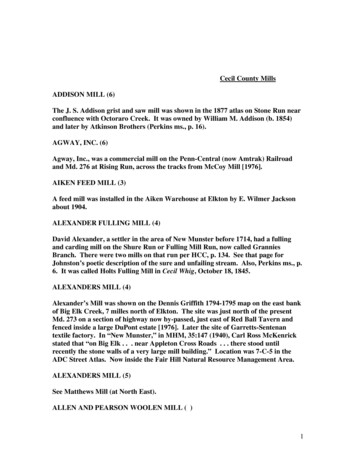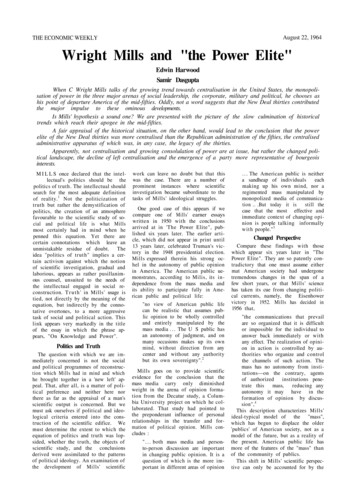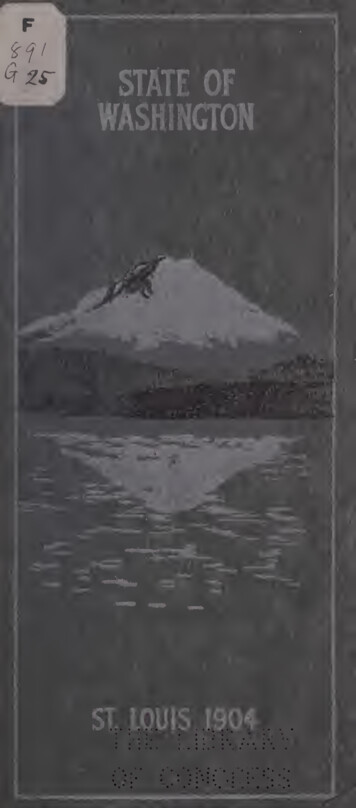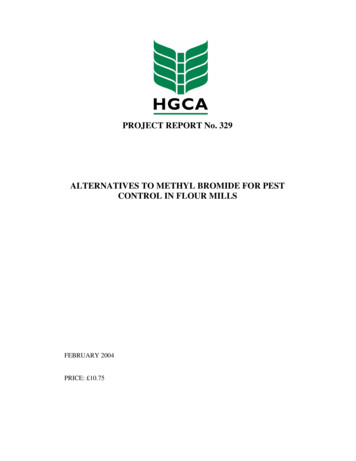
Transcription
Cecil County MillsADDISON MILL (6)The J. S. Addison grist and saw mill was shown in the 1877 atlas on Stone Run nearconfluence with Octoraro Creek. It was owned by William M. Addison (b. 1854)and later by Atkinson Brothers (Perkins ms., p. 16).AGWAY, INC. (6)Agway, Inc., was a commercial mill on the Penn-Central (now Amtrak) Railroadand Md. 276 at Rising Run, across the tracks from McCoy Mill [1976].AIKEN FEED MILL (3)A feed mill was installed in the Aiken Warehouse at Elkton by E. Wilmer Jacksonabout 1904.ALEXANDER FULLING MILL (4)David Alexander, a settler in the area of New Munster before 1714, had a fullingand carding mill on the Shure Run or Fulling Mill Run, now called GranniesBranch. There were two mills on that run per HCC, p. 134. See that page forJohnston’s poetic description of the sure and unfailing stream. Also, Perkins ms., p.6. It was called Holts Fulling Mill in Cecil Whig, October 18, 1845.ALEXANDERS MILL (4)Alexander’s Mill was shown on the Dennis Griffith 1794-1795 map on the east bankof Big Elk Creek, 7 milles north of Elkton. The site was just north of the presentMd. 273 on a section of highway now by-passed, just east of Red Ball Tavern andfenced inside a large DuPont estate [1976]. Later the site of Garretts-Sentenantextile factory. In “New Munster,” in MHM, 35:147 (1940), Carl Ross McKenrickstated that “on Big Elk . . . near Appleton Cross Roads . . . there stood untilrecently the stone walls of a very large mill building.” Location was 7-C-5 in theADC Street Atlas. Now inside the Fair Hill Natural Resource Management Area.ALEXANDERS MILL (5)See Matthews Mill (at North East).ALLEN AND PEARSON WOOLEN MILL ( )1
This works was listed at Bay View in 1861, Bishop, HAM, 3:556.ALLENDER MILL (3)Garrett A. Allender and his brother James Lawrence Allender came from HarfordCounty in 1915 and took over Ricketts Mill at the dead end of Walnut Lane, Elkton.In 1923, they purchased the Smith-Davis-Vinsinger Mill and took over the contractto pump city water; surplus water could be used for milling, but the town needed allthe water, and the partnership was dissolved and G. A. Allender closed both millsand set up a feed mill on the Pennsylvania Railroad in the former warehouse ofPowers Foundry. Later he took over the foundry itself (1939) and retailed seed,feed, and fertilizer, serving as Elkton’s only miller by 1956, Cecil County Directory,p. 270.ANDERSON MILL ( )Nathan Anderson, miller, was mentioned in a deed to John Wilson (1816) (CecilCounty deeds, JS 12:28).ANDERSON MILL (6)Norman H. Anderson was proprietor of this red wooden feed mill on the railroadsiding in Colora, supplying Red Rose Feeds [1968]. Later, the railroad was taken upand the mill closed; in 1988, it was being repaired.ARMSTRONG, SQUIRES MILL ( )“Armstrong, Squires, & Co., North East, Md., have recently had their millremodeled by Griscom & Co. & McFeely, Philadelphia, Pa., and speak very highlyof the improvement on the same. Their product comes in much more salablecondition as well as having the capacity increased,” American Miller, 17 (November1, 1889): 779.ARMSTRONG STOVE CO. (7)This iron casting works was operating at Port Deposit and Perryville, ca. 1861. TheBel Air Aegis, May 11, 1866, mentioned the works as making Emerald cook stovesand agricultural implements. The Bradstreet Directory of 1867 listed Armstrong &Co., stoves and tin ware, with a CC credit rating. The company’s papers are on filein the Historical Society of Cecil County, Elkton. A photo of shop workers appearedin Warren & Warren, Maryland Time Exposures (Baltimore, 1984), p. 74, It was athree-story, gable-roofed building with at Perryville per Esther R. Perkins andNancy C. Sawin in Backroading thru Cecil County, p. 3 [with line drawing], whereMs. Perkins stated, “Armstrong Foundry. How often one hears, ‘You could use anArmstrong heater.’ The mill once housed that industry. It is now occupied at one2
time by the Susquehanna Post 135, American Legion [1976].” The AmericanLegion later built a new headquarters. The Port Deposit Stove Works (Site) wasassigned MHT Inventory No. CE-298. Location was 8-J-7 in the ADC Street Atlas.ASKEW BARK MILL (9)D. B. Trimble advertised a “mill for grinding bark” on Christiana Road .5 millewest of Brick Meeting House, Cecil Whig, August 12, 1848. A tan bark mill on BigNorth East Creek, just north of Md. 273 and just downstream of a fulling mill, waslisted in the Perkins ms., p. 113.ASKEW TANNERY (9)David B. Trimble and Edward Askew, Executors, advertised in the Cecil Whig,January 15, 1848, to sell 40 acres of the late Peter Askew, a “Tan Yard with a twostoried brick tan-house; the yard containing 60 lay-away vats; seven leeches; eighthandlers, (under cover) with the usual number of limes, soaks, bates, &c, &c . . .contiguous to the lands of the Brick Meeting House . . . on the public road leadingto Wilmington; within a few yards of the road leading from Philadelphia toBaltimore . . . .”ATKINSON WOOLEN MILLS (5)See North East Woolen Mills.ATLAS POWDER COMPANY (7)The Bel Air Aegis, November 13, 1975, reported that an old badge was found atPerry Point reading “Agent United States Government, Perryville Plant” andstated, “This is a relic of a short period in 1919. According to a history book in theCecil County Library, this plant was built in six months, and was used to produceammonium nitrate for use in high explosives during World War I. Three monthsafter the completion of the plant, the Armistice was signed. In 1919, the site wasturned over to the U. S. Public Health Service for a Hospital.”BACK CREEK MILLS (2)Back Creek was in the lower part of the county, and Augustine Herrman’s map of1673 showed a mill on his manor near Back Creek. A more recent mill (perhapsthat of Howell James, q. v.) was purchased by W. H. Freeman along with BackCreek Farm (120 acres), July 7, 1847. The mill was equipped with two water wheelsand had grist, plaster, and clover mills under one roof. The estate rented for 1100and sold for 9400 (Partridge Papers, MHS Special Collections, Ms. 642). The Lakefamily were once millers at this works near Pivot Bridge. [Principio Creek was alsocalled Back Creek at one time but was in Election District 7, the name no longerused there.]3
The Baltimore Sun, August 15, 1870, reported that a storm washed out the dams ofBack Creek and Bohemia Mills.Joseph Salmon. Merchant miller and native of Delaware, was a patron of the 1877county atlas, which showed the location as close to the State line on Back Creekbetween Warwick and Pivot Bridge. About 1910, William Salmon became owner(Perkins Ms., p. 2). Back Creek, listed as a village on the Delaware line, 3.5 milleseast of Chesapeake City (GZMD, 1941), has disappeared in widening the C. & D.Canal. The mill was mentioned in the boundaries of the Sodom tract, HCC, p. 332.[Principio Creek was also called Back Creek, about 1722, HCC, p. 234.]BAKER MILL (5)Nathan Baker took out a writ of ad quod damnum on a branch of North East Rivernear its head, June 11, 1722. The land belonged to the Lord Proprietor and wasvalued at 15/6; it began near the country road to Susquehanna Ferry (ChanceryRecords, Liber 3:718, MSA). Oddly enough, Baker had sold the mill and mill site tothe Principio two months before. Nathan Baker appeared as a customer of NorthEast Forge on February 4, 1756, when that company provided “Smith’s Work to theBolting Mill Gears” (Principio Papers, N. E. Forge daybook, Delaware HistoricalSociety, Wilmington, 1978). See also, Principio Grist Mill in this chapter.BALDWIN AND COMPANY (3)See Elk Mills.BALDWIN SAWMILL (4)The 1877 county atlas showed Baldwin Sawmill on Big Elk upstream of Elk Mills.BARK MILL (9)See Askew Bark Mill.BARNETT MILL (5)See Scarborough Mill.BARNITE SAWMILL (4)The 1880 census of manufactures listed William Barnite with 4000 capitalinvestment in a sawmill on Big Elk with 2 employees, 1 circular and 1 Muley saw. A12-foot fall drove a 20 hp overshot wheel 12 ft broad to cut 75,000 ft ( 1500)annually.4
BARRETT PAPER CORP. LTD. OF MD. (3)A successor of Marley Mill, q. v.BEAZLEY TANNERY (5)Vats for 360 hides were advertised at the late Edward Beazley’s tannery at CharlesTown.BEE HIVE AND COOPER SHOP (4)Three stone houses and a ruin survive on the north side of Md. 273 (TelegraphRoad) west of Rock Presbyterian Church (1998). The MHT called it “Coopers Mill”in 1998. An historical sign reads, “The Beehive.” There was also a poster reading“Elk Creeks Preservation Society” (observed October 14, 1999). This cluster wasalso called “the Beehive” in Pamela James Blumgart, At the Head of the Bay (1996),p. 208, where it was described as a “cooper shop,” MHT Site No. CE-72. The endhouse surviving in 1999 was Michael Wallach’s Store (p. 352)). These buildingswere said to date from the 18th century. The 1858 county map by Martenet showedJohn Gallagher’s store. Not related to Rockville Paper Mill. There was a mysterypond upstream.BELL MILL (3)Bell Mill was a place name of 1882, served by Elkton post office, Industries of Md., p.60.BELLE MILLS (7)Belle Mills was a place name of 1882 near Port Deposit, Industries of Md., p. 60.Belle Mills was also listed in Polk’s 1908 peninsula directory but got its mail viaPort Deposit. Still listed in 1941 in GZMD.BENNETT MILL (5)See Dutton Mill.BIBB IRON FOUNDRY (7)The 1880 census of manufactures listed B. C. Bibb, Jr., with 16,100 capitalinvestment in an iron foundry at Port Deposit, with 38 employees, 30 hp steamengine, and 57,600 production. The office was in Baltimore. Also, CCM, p. 26.BLACKBURN IRON WORKS (6)5
The 1850 census of manufactures listed Manassah Blackburn as iron manufacturerwith 18,000 capital investment, 583 monthly payroll, and water-poweredproduction converting 500 tons of pig iron ( 14,000 cost) into 100 tons bar iron and300 tons of blooms worth 27,000 annually.BOHEMIA MILLS (2)A deed made in 1715 mentioned the “great road that leadeth to Bohemia Landing orMill” (Cecil County deeds, JH 2:328, MSA). Bohemia Mills, distinct from Priest’sMill, was on Sandy Branch Road (Md. 366) at Great Bohemia Creek near theDelaware line. The mill dated to 1678 per G. Harry Davidson.William Rumsey took out a writ of ad quod damnum on the “East Branch ofBohemia River called the Landing Branch being the middlemost of the threeBranches of said river or near Bohemia Landing dividing,” October 31, 1738. Theinquisition was taken at the Pipe Spring near the head of Bohemia River. Totaldamages were 45 Shillings awarded to John Thompson, Jr., Dr. Hugh Matthews,and William Rumsey, son of Charles. The parcels thus condemned were parts of thetracts: Adjonction, Manuaring Hall, and Heaths Third Parcel, respectively. Thejury found the site “principally sandy light soil” and there were a number of panelsof old fencing (Chancery Records, Liber 6:9, MSA).William Rumsey bequeathed “Mill Pond” and a mill to son Charles in 1747; he alsohad a “new mill” on Hicks Creek (Election District 1), which he left to his wife,HCC, p. 509. James Rumsey (1743-1792) was born here, and in 1782 operated amill at Sleepy Creek, Virginia, in partnership with a friend; the business lasted lessthan a year because Rumsey was absorbed in his inventions (DAB, 16:223).In December 1787, Rumsey successfully ran a boat by steam power atShepherdstown, West Virginia, An eye-witness letter in the Baltimore Md. Journal,February 8, 1788, noted that Rumsey had invented methods for more efficient use ofwater in mills and had improved the Savery steam engine for pumping water to fillmill wheels.“Murphy’s Mills” near the C. & O. Canal was mentioned in the Cecil Whig,September 21, 1851, p. 2. Bohemia Mills post office was established 1854. It wasalso called Bunker Hill Mill. The 1877 county atlas showed it as the T. C. Murphygristmill, Thomas Murphy’s per the 1867 Hawes Business Directory. Murphy wasalso the postmaster. The Cecil Whig, May 26, 1855, reported, “The mill dam of Mr.Thomas Murphy at Bohemia Mills washed out although there was no rain.” TheBaltimore Sun, August 15, 1870, reported that a storm washed out the dams of bothBack Creek and Bohemia Mills.The Lake familly succeeded Murphy, and shortly after that, it was bought by a Mr.Davidson. The mill then burned. See also, G. Harry Davidson, “History of Head ofBohemia, Rumsey’s Mill and the Early Custom’s House,” January 17, 1939, in MHS6
General Clipping file, s. v., “Cecil County.” The pond survives [1976], but the newbuilding is not a mill. Location was 22-K-8 in the ADC Street Atlas.BOOTH MILL (3)Jonathan Booth, Gentleman, took out a writ of ad quod damnum on the Little Elk,September 14, 1758. The inquisition taken at his house found damages to him of 15Shillings, and the same amount to Robert Evans, 7/6 to Zebulon Hollingsworth, and 1-2/6 to Adam Dawson, all yearly rents. The tract was part of Friendship “whereBoth intends to build a grist mill” (Chancery Records, Liber 9:40, MSA).The Red Mill existed ca. 1776 on Little Elk when the apprentice, Thomas C. Crouch,quit to become a bugler in the army, HCC, p. 516. The “Little Red Mill” wasmentioned as on the post road ca. 1780 in CCM, p. 52, where it was described as aHollingsworth Mill. In 1776, Henry Hollingsworth had taken out a warrant ofresurvey which was issued in 1782 as a patent of the tract “Hollingsworth andBooth” to him and Ebenezer Booth (Patents, Liber BC & GS 50:278, MSA).Colonel Henry Hollingsworth was having great difficulty procuring acceptable flourfor the army and he reported to Governor Lee on August 11, 1791, that he wasbolting and grinding flour in his own mill in hopes of passing inspection (Arch. Md.,47:410, 244).In 1786, Hollingsworth sold his half of the “Mills Water Mills Merchant Mills SawMills” to Ebenezer Booth, Miller (Cecil County deeds, 16:58, MSA). The next year,Jonathan Booth, Miller, bought land and water rights from Adam Dobson andmade an agreement with Zebulon Hollingsworth, owner of the next mill upstream,to share the water of Little Elk (Cecil County deeds 16:188-191, MSA). The 1789map by Christopher Colles (Plate 55) and the Dennis Griffith State map of 17941785 showed the mill west of Elkton, north side of the post road, east bank of theeastern fork of Little Elk. John Booth’s Merchant Mill was advertised with an 18foot fall by trustee, James Sewell, in the Baltimore American of July 13, 1818.The 1820 census of manufactures listed Abraham Bennett mill on Little Elk within 1mille of Elkton. The works had 2 pair of 4-foot, 6-inch stones, 3 bolting reels,packing press, elevators, and hopperboy, and was in bad repair. Consumption was7000 bu wheat, 1000 bu corn; there was one employee. The Cecil Whig listedPurnell’s as the lowest mill on “Little Elk” with 7 ft of fall (October 25, 1845). The1850 census of manufactures listed Greenbury Purnell with 3000 investment in awater mill, 1 employee, 2 run of stones, and annual output of 720 bbl flour, 5000 bumeal, 1000 bu feed, and 500 bu buckwheat ( 7150). Purnell received title to the millin 1852, following a suit against him filed by Washington Hall, Jr. (Cecil Countydeeds, HHM 1:260). In 1858, Purnell’s widow conveyed the land and mills to HenryH. Stites (Cecil County deeds, HHM 9:388); that same year the Martenet countymap showed General H. S. Stites gristmill on the east bank of Little Elk, north sideof the main road [the present US 40]. That map also showed the General’s7
warehouse on the railroad at Elkton south of the passenger station between Bridgeand Bow Streets.The mill passed to Mary A. Cameron, daughter of the General, and she was listed inthe 1877 atlas as farmer and miller, born in 1836. The 1880 census of manufacturesshowed Clarence Cameron with 7500 capital investment in the mill and an annualproduct up at 18,240, including 1800 bbl flour. Now with 3 run of stones, the millhad 100 bu/diem maximum capacity and did 75% custom business. A 10-foot falldrove 25 and 26-inch turbines at 140 rpm to develop 22 hp. A railroad accident atStiles [sic] Mill Crossing a mille south of Elkton was mentioned in the BaltimoreAmerican, June 6, 1881. The 1887 State business directory listed C. Cameron andBrother as millers. Mrs. Cameron died in 1907.The next owner or operator was Dominick McElwee. The American Miller, 9(August 1, 1881): 326, reported, “Mr. D. McElwee of 819 Washington Avenue,Philadelphia, has purchased a Rechard Turbine Water Wheel made by Geo. F.Baugher of York, Pa., which he will put in his large mill at Elkton, Md.” The samejournal of December 1, 1894 (22:910), reported, “The Red Flour Mill at Elkton,Md., owned by Dominick McEkwee, has been improved by much new machineryand a new steam power plant.” The same journal reported January 1, 1895 (23:72)that McElwee was “building . . . addition to his mill at Elkton.” Both mill andmiller’s dwelling burned about 1920. Location was 12-K-9 in the ADC Street Atlas.BOSLEY MILL (7)Edward Wilson and John Trimble advertised this new stone mill as 4 stories, 66 ftfront by 53 ft deep, with four pair of French burrs of 6-foot diameter. “All pit andsmall wheels except one are of iron . . . water guaranteed by canal company . . .Aaron Wilson residing at mill will show premises,” Baltimore Federal Gazette, April8, 1817. The works was mentioned in a clipping found in the Partridge scrap book,“For Sale, July 10, 1845—mill seat near Port Deposit near the Tidewater Locks . . .on the East side of the Susquehanna Canal . . . Mill Seat Lot No. 4, whereon a SawMill is erected . . . (the quantity of water which was found to be required by themill erected on these lots by the late James Bosley, Esq., which was afterwardsdestroyed by fire, was about 1140 inches delivered under a head of 3 feet 1-1/2inches, the head and fall, from the surface of the Canal to the termination of the tailrace at the River, being about 24 feet) – Charles Nicholas – trustee.” The BosleyMill also had an 80-foot long barrel house.This advertisement masks the history of Bosley’s disaster. The mill had been builtby Edward Wilson of Philadelphia, Wilson bought the land for 6000 from thecanal company with water rights sufficient to run six pairs of millstones of 6-footdiameter to be driven by water wheels of not less than 15-foot diameter. The waterturned out to be insufficient, and after Bosley acquired the mill he entered into adispute with the canal company. The company advertised in the Baltimore papersthat they intended to grant only that quantity of water agreed upon in the deed. Mr.8
Bosley turned on the water in defiance and ran the mill at such speed that it tookfire from the friction and was destroyed, HCC, p. 394.A full column advertisement for the Bosley Mill site with its burned mill appeared inthe Baltimore American, July 2, 1845. Years later, another advertisement offeredthe Bosley Mill Seat or Burnt Mill, Port Deposit, at the terminus of the oldMaryland Canal, Baltimore American, May 30, 1856. Location was 8-H-7 in theADC Street Atlas.BREWSTERS MILLS (4)The 1858 county map showed this works downstream of the present BrewsterBridge Road, west side. The 1877 county atlas showed Brewsters Mills at Elk Millson Big Elk Creek near Montgomery. John Brewster advertised as manufacturer ofcotton yarn, cotton lap, flax, and counterpanes. The Baltimore American, October8, 1877, reported “flood damage at Mr. Brewster’s cotton factory.” The 1880 censusof manufactures showed a capital investment of 34,000, listing 30 employees, 14 ofthem children; a 60 hp steam engine and a 48 hp turbine 48 inches broad driven at80 rpm by an 11-foot fall on Big Elk powered an annual production of 40,000. Themill was closed in the 1880s. The bell was preserved at the Historical Society ofCecil County. The Cecil Whig, March 22, 1972, reported, “Bulldozers Soon to EndLong Life of Historic Brewster’s Mill,” on Big Elk Creek at Elk Mills. The articlecontained photographs by Larry Powell of the “last remaining structure of BaldwinManufacturing Mills. “The small, stone row houses that lined Elk Mills Road foralmost as long have been laid to rubble by bulldozers. Brewsters Mill is due to fallnext.” See also the neighboring Elk Mills. Location was 7-C-11 in the ADC StreetAtlas.BRICKLEY MILL (6)Same as Jacksons Mill.BRITTAIN MILL ( )The Brittain Mill was purchased in December 1832 by Jethro McCullough and wasupstream of Joseph R. Brown mill (Partridge Papers, MHS Special Collections, Ms.No. 642). The stream was not identified.BROOKINGS AND CHRISTY PAPER MILL (4)Same as Rockville Paper Mill,BROWN MILL ( )9
Joseph R. Brown’s Mill was downstream of the Brittain Mill and was purchased inDecember 1832 by Jethro McCullough (Patridge Papers, MHS Special Collections,Ms. No. 642).BROWN MILL (4)The 1880 census of manufactures listed Earnest Brown with 8000 capitalinvestment in a custom mill on Little Elk with 2 employees, 3 run of stones, 100bu/diem maximum. A 22-foot fall drove two 24 hp, 2.5-foot Vernon wheels at 200rpm. Annual output was 1444 bbl flour, 199 tons meal, and 57.5 tons feed ( 13,000).BROWN MILL (MATTHEWS) (9)In 1829, John Williamson mortgaged this mill on North East Creek to NathanielWiley, who foreclosed in 1832. Thomas C. Ewing bought it and in 1838 sold to JohnA. Brown (Cecil County deeds, JB 41:195). The Cecil Whig listed John AllenBrown’s Mill on Big North East as a grist and clover mill, November 1, 1845.Brown sold in 1849 to John and Charles Matthews (Cecil County deeds, RCH1:347) and in 1853, Charles Matthews became sole owner (Cecil County deeds,HHM 1:583).Martenet’s 1858 county map showed Charles Matthews mill at the present KirksMill Road (Detour Road) and the Hawes Business Directory of 1867 listed him with agrist and saw mill at Bay View. The 1867 Bradstreet Directory listed CharlesMatthews with a mill at Zion with an AABB credit rating. The 1877 atlas showedthe W. R. Matthews mill. Matthews was also an atlas patron, a native of BucksCounty, having settled in Cecil in 1850. The Baltimore County Union, Towsontown,April 14, 1877, reported the burning of the grist and flour mill of W. L. Matthewson Big North East Creek, Cecil County.The 1880 census of manufactures listed William K. Matthews with 3000 capitalinvestment in a water mill with 2 employees, 2 run of stones, 70 bu diem/maximumcapacity, doing 87% custom business. A 9.5-foot fall on North East drove a 10 hp,27-inch Eclipse wheel at 90 rpm. Annual output was 2000 bbl flour, 320,000 lbmeal, 150,000 lb feed, and 25,000 lb buckwheat ( 23,350). The mill is extinct. Seealso Kirk’s Mill (in Election District 9).BROWNS MILL (TRIMBLES) (9)Deeds show that the first owners were William Cole, Sr., followed by JeremiahBrown, who was the miller in 1734. Jeremiah Brown was a Quaker from ChesterCounty, Pa., and had come to Maryland in 1702 with his parents when theypurchased 2500 acres from William Penn. The next owner was Jeremiah Brown, Jr.In 1779, the mill passed to Brown’s son-in-law, John Lewden, and Rachel; BrownLewden; next to Joseph Haines, acting for Joseph Reynolds. In 1800, John Phillipsbecame owner; then James Janney, Leven Gale, and in 1833, Eli and Morris10
Hurford. The Cecil Whig list entitled “North East” placed this mill as Hurford’s onBig North East Creek and showed 12 to 14 foot of fall, November 1, 1845.Martenet’s 1858 county map showed Hurford Mill.The atlas listed Robert Trimble, and the 1880 census of manufactures carriedWilliam N. Trimble with 2400 capital investment in a mill with 2 employees, 50bu/diem maximum capacity, and 2 run of stones, doing 75% custom business. A10.5-foot fall drove an overshot wheel 10.5 ft broad at 20 rpm to develop 7 hp.Annual output was 133 bbl flour, 138 tons meal, 45 tons feed, and 6.2 tonsbuckwheat ( 13,500).The mill passed to Howard Brown and from his heirs to John Barry. In 1946, it wasacquired by Joseph E. Plumbstead. The dam and race were restored in 1961.Edwin Plumbstead, an architect, restored the mill as a private farm museum andstudio in the 1960s (Perkins ms., p. 12f).Jeremiah Brown Mill in1968, MHT photo.The mill was struck by lightning and burned on June 26, 1971. The fire enginesfrom Rising Sun were only able to pump mud from North East Creek, which hadrecently been silted up by widening Md. 273. Plumbstead’s antiques, includingIronmaster John England’s Conestoga wagon, were destroyed. See, “Fire RazesHistoric Mill Near Calvert,” Dot Clark, Cecil Whig, June 30, 1971. Plumbsteadrebuilt the mill, Sun Magazine, July 29, 1973. The site is on the south side of Md.273, west of the creek, and east of Hatchery Road.The Jeremiah Brown House and Mill Site were nominated to the National Registerby the Governor’s Consulting Committee, January 18, 1988 (SWAP, JanuaryFebruary 1988, p. 1. The mill dwelling and mill were assigned MHT Site No. CE203. Location is 4-G-4 in the ADC Street Atlas.BROWNS SAW AND GRIST MILL (7)11
The 1877 county atlas showed this mill near the house of Mrs. S. R. Brown onPrincipio Creek upstream of Jennings grist and saw mills.BROWN SAWMILL ( )The Baltimore Sun, September 19, 1844, reported a fire in Mr. Isaac Brown’s steamsaw and turning mill at Perryville in Cecil County; the mill was wholly consumedand an immense quantity of finished work, chairs, window sashes, etc., was lost.The fire was accidental.BUCK SAWMILL (7)J. J. Buck was listed as sawmiller at Port Deposit in the 1887 State directory. Theatlas showed the steam sawmill at the SE corner of Cedar Street and the present US222. The 1880 census of manufactures showed John J. Buck with 2500 capitalinvestment in a 30 hp steam sawmill with 7 employees, 1 circular saw, and annualoutput of 500,000 ft ( 10,000) over an 8-month season.BULLOCK MILL (4)The 1850 census of manufactures listed Thomas Bullock with 2000 capitalinvestment in a water mill with 1 employee, 2 run of stones, and 1 saw; annualoutput was 2000 qt buckwheat, 220 bbl flour, 1000 bu each of meal and of corn-oats,plus 20,000 ft plank ( 3420).BUNKER HILL MILL (2)Same as Bohemia Mill.BURGETT SAWMILL (2)H. Burgett’s steam sawmill was shown in 1877 county atlas at Chesapeake City onthe south side of the canal and west of the pump house; also an illustration; millextinct.BURNS WOOLEN MILL (5)See Providence Woolen Mills.CALDWELLS AND JENNESS SAWMILL (8)The 1887 county atlas showed this sawmill on Conowingo Creek at Conowingo PostOffice.CAMERON MILL (3)12
Same as Booths Mill of 1795.CANISIUS MILL (7)See New Valley Factory.CARNEN MILL (7)The 1820 census of manufactures listed David Carnen with 1500 capital investmentin a water mill with 1 employee and 2 pair of burrs; annual output was 110 bblflour, 800 bu meal, 500 bu feed, 200 qt buckwheat and offal ( 2181),CARTER MILL ( )A freshet in Little Elk Creek washed out the dam of William Carter, Sun, October6, 1855. No sure what mill this matches.CARTER PAPER MILL (3)This mill was started in 1816 by Robert Carter of Delaware County, Pa., The 1820census of manufactures listed Robert Carter with Caecil Paper Mill on Little Elk, 5milles from Elkton; the building was stone and frame, equipped with 2 vats and 4screws. Annual output was 8000 in binders, box boards, writing and wrappingpapers made from 22 tons rags and 30 tons of rope; 17 employees. The business wasat the lowest ebb in years per the comments entry.Carters Paper Mill at Elkton was destroyed by fire, Baltimore Sun, May 31, 1838.The Baltimore Republican & Argus, April 28, 1846, reported “New Paper Mill,” thatof Robert Carter and Sons at Marley. Robert Carter died in 1852, and the businesswas continued by his son, I. Day Carter. The Cecil Democrat, October 3, 1863,stated, “I. D. Carter has purchased the Rock Paper Mills along Elk Creek, nearCherry Hill for 4000.” The 1877 county atlas showed two mills, one on Little ElkNW of Cherry Hill, the other on the same creek downstream of Levis Mill. Theworks was later owned by a son, Charles Carter.The Baltimore American, October 8, 1877, under “The Late Storm,” reported thatthe George W. Childs paper mill on Little Elk had its dam washed out, and 400 tonsof straw washed away.The 1880 census of manufactures in District 3 listed Cecil Paper Mills with 55,000capital investment, 20 employees, and annual output of 510 tons of wallpaper( 76,000). A 21-foot fall on Little Elk drove a 40 hp overshot wheel 11 ft broad at 6rpm. There was also a 12 hp steam engine. Under “tub Engines” were listed 2washers with 36-inch diameter rolls, of 3400 lb maximum capacity; 1 beater of samedimensions; also a 66-inch wide Fourdrinier paper machine. The mill burned13
December 19, 1900, and was not rebuilt. For many years, it had supplied all thenewsprint for the Baltimore Sun, CCM, p. 75. Also, HCC, p. 476.The Sun, December 20,1900, began with the headline, “Carter Paper Mill HistoricCecil County Industry Destroyed by Fire. Appeal to Elkton for Help But the FireEngines Could Not Get over the Back Road in Time. The Mill Was Making WallPaper.” The paper noted that the works was operated by McQuilkin & Company.The fire originated in the boiler room, thanks to an oil lamp explosion. The boilerroom was the first building to go, followed by the storeroom. George McQuilkin ofElkton was president, Charles Carter secretary-treasurer. The directors includedHenry A. Carter of New York Haven Paper Company, Robert D. Carter ofWinaque Paper Company of New Jersey.The Sun of December 21, 1900, included a story, “Cecil County. A Verdict Againsta Rail Road Company—The Carter Paper Mill.” The follow-up story on the firewas a s follows, “The destructive fire at the Carter Paper Mills, on Little Elk Creek,six milles north of Elkton, last evening almost completely wiped out every buildingconnected with the plant, thus destroying one of Cecil’s industries. The bucketbrigade, which was formed a s soon as the fire started, by hard work succeeded insaving the beater mill, but was powerless to prevent the destruction of the rest of theproperty. The contents of the mills were destroyed along with the buildings.Including mac
and Md. 276 at Rising Run, across the tracks from McCoy Mill [1976]. AIKEN FEED MILL (3) . stated, “This is a relic of a short period in 1919. According to a history book in the Cecil County Library, this plant was built in six months, and was used to produce . son of Charles










